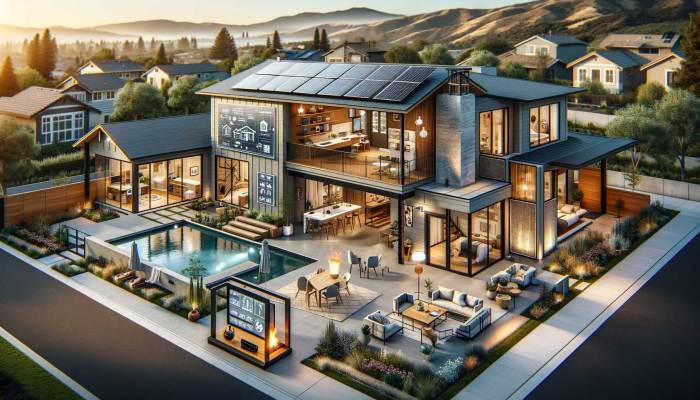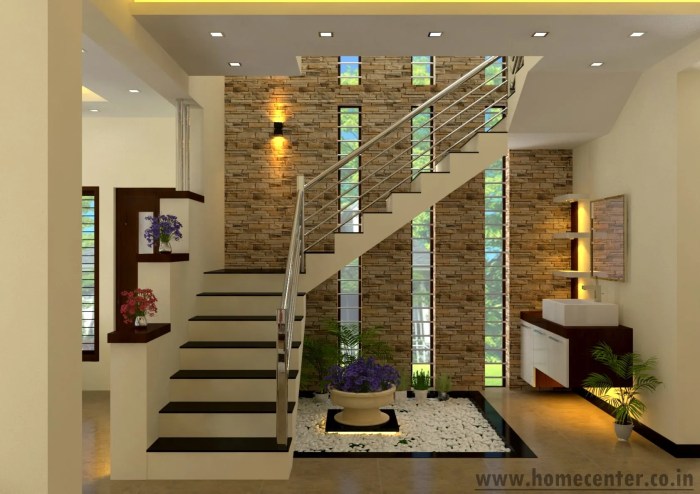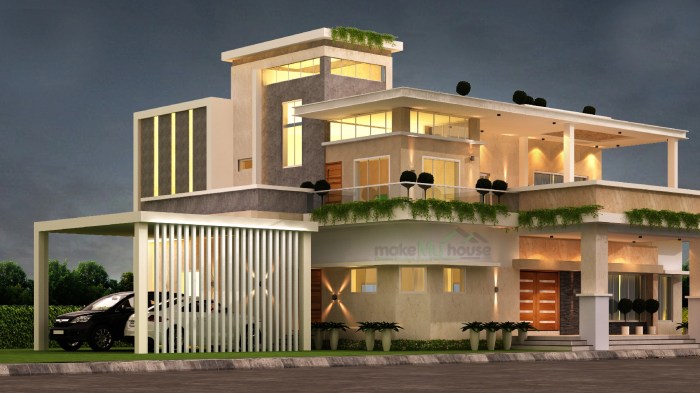Crafting a Stunning Home Design: Elevating Functionality and Aesthetics
Home design sets the stage for this enthralling narrative, offering readers a glimpse into a story that is rich in detail and brimming with originality. From the impactful significance of well-thought-out design to the intricate elements that shape our living spaces, this exploration delves into the essence of creating a home that truly reflects one's style and personality.
As we journey through the various styles, elements, and sustainable practices in home design, a world of possibilities unfolds, showcasing the transformative power of thoughtful design choices.
Importance of Home Design

Home design plays a crucial role in creating a space that is not only visually appealing but also functional and conducive to overall well-being. A well-thought-out design can significantly impact daily life in various ways.
Enhancing Functionality
Good home design can enhance functionality by optimizing the layout of the space to make it more efficient and practical. This may involve considerations such as proper placement of furniture, adequate storage solutions, and seamless flow between rooms.
Improving Aesthetics
In addition to functionality, home design also focuses on enhancing the aesthetics of a space. Through the use of colors, textures, lighting, and decor, a well-designed home can create a harmonious and visually pleasing environment that promotes relaxation and comfort.
Impact on Well-being
The design of a home can have a direct impact on the well-being of its occupants. Factors such as natural light, ventilation, and overall layout can influence mood, productivity, and overall quality of life. A thoughtful design that takes into account the needs and preferences of the residents can contribute to a sense of contentment and happiness.
Elements of Home Design
When designing a home, several key elements play a crucial role in creating a cohesive and aesthetically pleasing space. Elements such as lighting, color schemes, and furniture layout all contribute to the overall look and feel of a home.
Lighting
Proper lighting is essential in home design as it not only illuminates the space but also sets the mood and ambiance. Different types of lighting, such as ambient, task, and accent lighting, should be strategically placed to create a well-lit and inviting atmosphere.
Color Schemes
Color schemes can greatly impact the overall design of a home. Whether you opt for a monochromatic palette for a more minimalist look or incorporate bold colors for a statement, choosing the right color scheme can tie the design elements together and create a cohesive visual flow throughout the space.
Furniture Layout
The placement and arrangement of furniture in a home can significantly impact the functionality and aesthetics of the space. Proper furniture layout considers traffic flow, focal points, and the overall balance of the room. By arranging furniture in a way that maximizes space and functionality, you can create a harmonious and well-designed living environment.
Popular Home Design Styles
When it comes to home design, there are several popular styles that homeowners can choose from to create a cohesive and aesthetically pleasing space. Each style has its own unique features and characteristics that set it apart from the others.
Let's explore some of the most common home design styles and how they can be incorporated into your own space.
Modern Home Design
Modern home design is characterized by clean lines, open spaces, and a minimalist aesthetic. Neutral colors, sleek furniture, and a focus on functionality are key elements of modern design. To incorporate this style into your home, opt for simple furniture pieces, uncluttered spaces, and a neutral color palette with pops of bold accents.
Traditional Home Design
Traditional home design is all about classic elegance and timeless appeal. Rich wood tones, intricate detailing, and plush furnishings are hallmarks of traditional design. To achieve a traditional look in your home, opt for ornate furniture pieces, luxurious fabrics, and a warm color palette with traditional patterns like florals and stripes.
Minimalist Home Design
Minimalist home design focuses on simplicity, functionality, and a sense of calm. Clean lines, clutter-free spaces, and a neutral color palette are key elements of minimalist design
Industrial Home Design
Industrial home design is inspired by urban lofts and warehouses, featuring raw materials, exposed structural elements, and a utilitarian aesthetic. Reclaimed wood, metal accents, and unfinished surfaces are common in industrial design. To add an industrial touch to your home, incorporate raw materials like steel and concrete, exposed pipes and ducts, and vintage industrial lighting fixtures.
Scandinavian Home Design
Scandinavian home design is known for its simplicity, functionality, and connection to nature. Light, airy spaces, natural materials, and a neutral color palette are key elements of Scandinavian design. To achieve a Scandinavian look in your home, incorporate natural wood accents, cozy textiles, and a muted color palette with pops of soft pastels.
Sustainable Home Design

When it comes to sustainable home design, the focus is on creating living spaces that have minimal negative impact on the environment while maximizing energy efficiency and promoting a healthier lifestyle.
Integrating sustainability into home design is crucial in today's world, where environmental concerns are at the forefront of discussions. By choosing eco-friendly materials and energy-efficient solutions, homeowners can reduce their carbon footprint and contribute to a more sustainable future.
Eco-Friendly Materials
- Reclaimed wood: Using reclaimed wood from old buildings or furniture not only adds character to a home but also reduces the demand for new timber, helping to preserve forests.
- Bamboo: Bamboo is a rapidly renewable resource that can be used for flooring, furniture, and even structural elements in a home.
- Recycled glass: Incorporating recycled glass into countertops or tiles reduces the need for new raw materials and helps divert waste from landfills.
Energy-Efficient Solutions
- Solar panels: Installing solar panels on the roof can help to generate clean and renewable energy, reducing reliance on traditional power sources.
- LED lighting: LED bulbs are more energy-efficient and have a longer lifespan compared to traditional incandescent bulbs, helping to lower electricity consumption.
- High-efficiency appliances: Energy Star-rated appliances consume less energy, saving money on utility bills and reducing greenhouse gas emissions.
Benefits of Sustainability in Home Design
- Cost savings: Energy-efficient homes often result in lower utility bills, saving homeowners money in the long run.
- Improved indoor air quality: Using eco-friendly materials and proper ventilation systems can lead to better indoor air quality, promoting a healthier living environment.
- Reduced environmental impact: By choosing sustainable design practices, homeowners can minimize their carbon footprint and contribute to a greener planet.
Final Thoughts

In conclusion, home design is not just about aesthetics but about creating a space that nurtures well-being, functionality, and sustainability. By understanding the importance of design elements and exploring different styles, individuals can embark on a creative journey to transform their living spaces into personalized sanctuaries that resonate with their unique vision.
FAQ Insights
How does home design impact daily life?
Home design influences mood, productivity, and overall well-being by creating spaces that are functional, visually appealing, and reflective of personal style.
What are some key elements to consider in home design?
Key elements include lighting, color schemes, furniture layout, and the use of textures and patterns to create a cohesive and inviting atmosphere.
Why is sustainable home design important?
Sustainable home design promotes environmental responsibility, energy efficiency, and healthier living spaces by using eco-friendly materials and practices.




